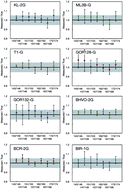High-precision measurement of Eu/Eu* in geological glasses via LA-ICP-MS analysis†
Abstract
Elemental fractionation during laser ablation inductively coupled plasma mass spectrometry (LA-ICP-MS) analysis has been historically documented between refractory and volatile elements. In this work, however, we observed fractionation between light rare earth elements (LREEs) and heavy rare earth elements (HREEs) when using ablation strategies involving large spot sizes (>100 μm) and line scanning mode. In addition (1) ion yields decrease when using spot sizes above 100 μm; (2) (Eu/Eu*)raw positively correlates with carrier gas (He) flow rate, which provides control over the particle size distribution of the aerosol reaching the ICP; (3) (Eu/Eu*)raw shows a positive correlation with spot size, and (4) the changes in REE signal intensity, induced by the He flow rate change, roughly correlate with REE condensation temperatures. The REE fractionation is likely driven by the slight but significant difference in their condensation temperatures. Large particles may not be completely dissociated in the ICP and result in preferential evaporation of the less refractory LREEs and thus non-stoichiometric particle-ion conversion. This mechanism may also be responsible for Sm-Eu-Gd fractionation as Eu is less refractory than Sm and Gd. The extent of fractionation depends upon the particle size distribution of the aerosol, which in turn is influenced by the laser parameters and matrix. Ablation pits and lines defined by low aspect ratios produce a higher proportion of large particles than high aspect ratio ablation, as confirmed by measurements of particle size distribution in the laser induced aerosol. Therefore, low aspect ratio ablation introduces particles that cannot be decomposed and/or atomized by the ICP and thus results in exacerbated elemental fractionation. Accurate quantification of REE concentrations and Eu/Eu* requires reduction of large particle production during laser ablation. For the reference materials analyzed in this work, the 100 μm spot measurements of Eu/Eu* agreed with GeoRem preferred values within 3%. Our long-term analyses of Eu/Eu* in MPI-DING glass KL-2G and USGS glass BIR-1G were reproducible at 3% (2 RSD).


 Please wait while we load your content...
Please wait while we load your content...